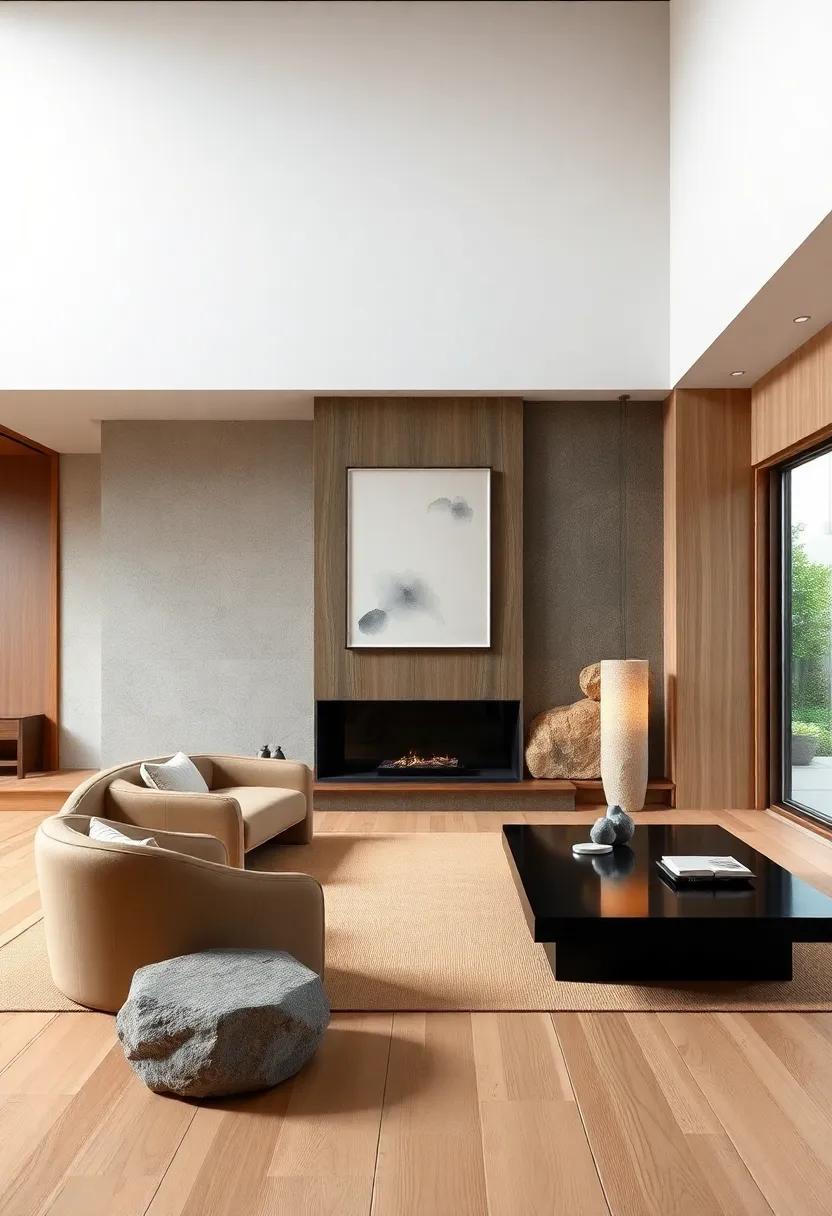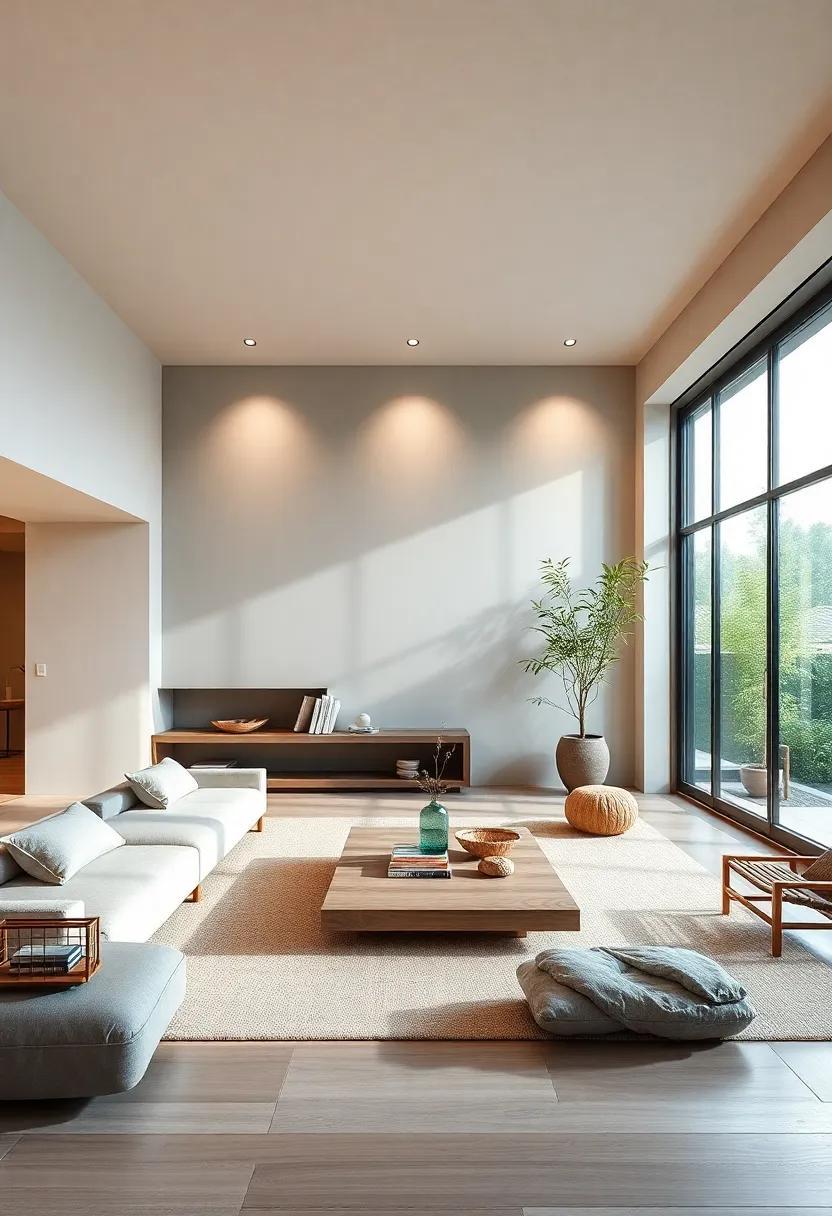In the gentle embrace of nature, design finds its essence. Japanese living rooms, renowned for their minimalist elegance, often weave in elements that echo the tranquility of the outdoors. Among these, natural stone accents stand out as timeless features that harmonize beauty and functionality. This article explores the enchanting synergy between traditional Japanese aesthetics and the tactile warmth of stone, delving into how these organic elements can transform living spaces into serene sanctuaries. From the polished surfaces of slate to the rustic charm of river stones, discover how incorporating natural stone can elevate the tranquility of your home, creating a seamless connection to the beauty of the natural world. Join us as we uncover the art of integrating these earthy materials, inviting a sense of balance and peace into the heart of Japanese design.
Embracing Tranquility: The Role of Natural stone in Japanese Interior Design

Natural stone holds a special place in Japanese interior design,serving as a bridge between the built environment and the natural world. Its textured surfaces and organic hues can evoke a sense of calm, allowing for a serene atmosphere that is essential in traditional Japanese aesthetics. Stone, whether used as flooring, wall cladding, or even subtle accents, brings an earthy element that harmonizes with other materials, such as wood and paper. The simplicity and elegance of stone can transform a living room into a peaceful retreat, where nature and modern living coexist beautifully.
Incorporating natural stone requires thoughtful consideration of placement and design,enhancing the overall ambiance while maintaining the beliefs of Wabi-Sabi,which celebrates imperfection. By selecting specific types of stone, such as granite or limestone, homeowners can create versatile spaces that embody tranquility. Consider these factors when embracing natural stone in your living area:
- Texture: Opt for stones with varied textures to add depth.
- Color palette: Choose earthy tones that complement existing decor.
- Functionality: Think of stone not just as decor, but practical surfaces like tabletops or fireplaces.
Timeless Elegance: The Aesthetic Appeal of Stone Accents in Living Spaces

In the pursuit of aesthetic harmony, stone accents serve as a bridge between the natural world and the serenity of indoor spaces. granite, marble, and river stones are not merely materials; thay are tactile experiences that evoke the beauty of nature, seamlessly integrating into the minimalist ethos of Japanese design. Incorporating stone elements into living rooms,such as feature walls or decorative sculptures,creates a visual focal point that enhances the room’s tranquility. The coolness of stone juxtaposed with the warmth of wood furnishings offers a delightful contrast, inviting a sense of balance and calm.
The use of stone in decor extends beyond mere aesthetics; it embodies functionality and longevity. Consider the following ways to embrace stone accents:
- Stone Hearths: Providing warmth and a gathering spot for family and friends.
- Accent Tables: Unique pieces that serve as conversation starters.
- Wall Art: Carved stone pieces that bring depth and texture.
- Planters: Incorporating stone containers to house greenery enhances the natural feel.
utilizing stone brings with it an array of textures, colors, and patterns that can elevate any space. Whether as a backdrop to traditional tatami mats or a sophisticated edge to modern furnishings, stone accents are pivotal in creating a living room that truly resonates with the essence of nature.
Connecting with Nature: How Natural Stone Enhances Japanese Design Philosophy

Incorporating natural stone into Japanese design creates a serene ambiance that resonates with the philosophy of wa, or harmony. This dedication to balancing elements can be achieved through the selection of materials that not only serve a functional purpose but also evoke a sense of tranquility. Utilizing slate, granite, or marble as accent features, such as tabletops, accent walls, or flooring, allows for an organic connection to the environment. The textures, colors, and patterns of natural stone can vary dramatically, each piece telling its own story while enhancing the overall aesthetic of the living space.
Furthermore, natural stone components in design foster a deeper thankfulness for the changing seasons, a principle central to Japanese culture. by embracing these authentic materials, homeowners cultivate a peaceful retreat that reflects the beauty of nature both indoors and outdoors. The integration of stone complements traditional elements like shoji screens and tatami mats, effectively bridging the gap between the structure and its surroundings. Consider these advantages of using natural stone:
- Durability: Long-lasting and withstands time.
- Natural Aesthetics: Unique appearances and variety.
- Textural contrast: Enhances visual interest and depth.
Balancing Elements: Integrating Stone with Wood and Other Natural Materials

In the quest for a serene and balanced living environment, the combination of stone and wood emerges as a timeless choice, enhancing the natural beauty of Japanese living rooms. Natural stone,with its raw,rugged textures,stands in striking contrast to the warmth of wood,introducing an element of groundedness. The interplay of these materials creates a visual dialog, allowing each element to shine while contributing to a unified aesthetic. Opting for features such as a stone accent wall or a solid wood floor not only delineates spaces but also invites nature indoors, fostering a sense of tranquility that resonates deeply with Japanese design philosophy.
To further elevate this harmonious blend, consider incorporating other natural materials like bamboo or linen, which can add layers of texture and softness to the space. Such combinations create an inviting atmosphere, perfect for relaxation or contemplation. Here are a few tips on how to masterfully integrate these elements:
- Accent Features: Utilize stone for focal points like fireplaces or garden walls.
- Complementary colors: Choose wooden furnishings with tones that complement the colors of your stone.
- Textural contrast: Pair rough-hewn stone with smooth wooden surfaces to enhance tactile variety.
- natural Lighting: Use large windows to allow natural light to highlight the textures and colors of both materials.
Serene Color Palettes: The Influence of Stone Hues on room Atmosphere

Color palettes inspired by natural stone possess an inherent ability to evoke tranquility and sophistication within a space. Shades of soft greys, muted beiges, and earthy browns echo the calming essence of marble, granite, and river stones. These hues can create a serene backdrop that enhances the beauty of wooden elements commonly found in Japanese interiors.When integrated thoughtfully, stone-inspired colors can foster a harmonious balance between modern aesthetics and the traditional warmth of natural materials.Here are some benefits of using stone hues in living spaces:
- Warmth and Comfort: Soft colors create a welcoming ambiance.
- Timeless Appeal: Stone tones are classic and never go out of style.
- Versatility: They pair well with both vibrant and subdued decor.
incorporating these soothing shades into a room can dramatically influence its emotional resonance. The use of stone-inspired hues not only enhances the physical aspects of the decor, but also contributes to a deeper feeling of peace and balance. Consider the impact of a light stone accent wall complemented by dark wooden furniture, or muted stone-colored textiles harmoniously woven into the setting. A well-thoght-out combination can lead to a space that feels both grounded and expansive, promoting relaxation and introspection. Such as, a simple color palette inspired by natural stones can be visually represented as follows:
| Color | Hex Code | Associated Emotion |
|---|---|---|
| Soft Gray | #C2C2C2 | Calm |
| Muted Beige | #D9C4A0 | Comfort |
| Earthy Brown | #A0522D | Grounded |
Textural Harmony: Layering Stone Accents for a Rich Design Experience

Incorporating stone accents into a Japanese living room offers a unique opportunity to create depth and harmony within the space. By layering various types of stone—such as granite, slate, and limestone—you can achieve a complex yet cohesive aesthetic that draws on nature’s own palette. consider using smooth polished stone for tabletops and rough-textured brick for accent walls. such contrasts not only enhance the tactile experience of the room but also promote an organic feel that resonates with traditional Japanese design principles. Color combinations like earthy browns,cool greys,and soft whites can definitely help facilitate a tranquil and grounding atmosphere.
To further enhance the visual appeal, think about integrating stone elements in furniture pieces and decor. Here are some creative ways to layer stone accents effectively:
- Accent Walls: Use natural stone slabs to create a stunning focal point.
- Fireplaces: Frame a fireplace with rough-hewn stones to add rustic charm.
- Art Installations: Incorporate sculptural stone pieces to serve as conversation starters.
- Natural Tables: Select side tables or coffee tables with stone bases for added elegance.
The Essence of Space: Strategic placement of Stone in Japanese Living Rooms

In the heart of a Japanese living room, the placement of natural stone takes on a profound importance, bridging indoor and outdoor environments. Each stone, whether it be a smooth river rock or a rugged slab of granite, serves to enhance the feeling of tranquility and connection to nature. The strategic arrangement of these stones allows for not just aesthetic pleasure but also promotes a sense of flow and harmony throughout the space. By incorporating stones into key areas like:
- Hibachi fire pits for warmth and social interaction,
- Features in tokonoma alcoves to highlight seasonal changes,
- Wall accents that evoke natural landscapes,
homeowners create a soothing backdrop that reflects the changing seasons and natural beauty.This thoughtfulness in placement not only adds visual weight but also encourages movement,guiding the flow of daily life while offering mindfulness and serenity.
Furthermore, the choice of stone types and finishes amplifies the spatial experience, allowing for varied textures and colors to resonate with the room’s overall palette. lighter stones may illuminate and expand smaller spaces, while darker, more textured stones can add depth and contrast, creating focal points that draw the eye. Below is a succinct overview of popular stone types and their potential uses:
| Stone Type | Ideal Use | Effect on Space |
|---|---|---|
| Granite | Feature walls | Durability and luxury |
| Slate | Flooring | Earthy warmth |
| River Rock | Garden integration | Natural flow |
| Limestone | Countertops | Simplicity and elegance |
Such deliberate choices and placements encourage an environment that not only shelters but also inspires, resonating with the principles of Zen and simplicity that are central to Japanese aesthetics.
craftsmanship and Heritage: Appreciating the Artistry of Natural Stone

The artistry of natural stone is not just in its aesthetic appeal,but also in the rich craftsmanship that brings each piece to life. Every stone carries its own history, shaped by time and the elements, making it a unique element in interior design. When incorporated into Japanese living rooms, natural stone accents harmonize with traditional craftsmanship, such as tatami mats and shoji screens, creating an atmosphere of tranquility and elegance. The subtle hues and textures of stones like granite,marble,and slate add depth and character,enriching the serene spaces where simplicity reigns supreme.
Moreover, embracing natural stone in home decor serves as a testament to cultural heritage, reflecting a deep appreciation for nature’s artistry. Incorporating these materials can take various forms:
- Accent walls that showcase striking patterns and formations
- Custom-made furniture that combines stone with natural woods
- Flooring that seamlessly blends indoor and outdoor spaces
- Tabletops that highlight intricate veining and color variations
By choosing natural stone, homeowners not only rejuvenate their living spaces but also preserve the legacy of traditional craftsmanship, fostering a timeless connection to the art of design.
Footprints of Nature: Bringing Outdoor Elements into Indoor Spaces

Embracing the essence of the great outdoors within a living space can transform a home into a tranquil sanctuary. utilizing natural stone accents evokes feelings of earthiness and connection to nature. Granite,marble,and slate are not just visually appealing; they also embody resilience and timeless beauty,making them perfect for Japanese living rooms. Consider incorporating these materials in features like:
- Accent walls that create depth and drama.
- Tabletops that serve as functional art pieces.
- Fireplace surrounds that bring warmth and a rustic touch.
Moreover, the integration of these natural elements can significantly enhance the overall aesthetics and ambiance of the room. one effective way to harmonize stone accents with traditional Japanese design is through careful selection of colors and textures. Pair rich stone finishes with softer fabrics and minimalistic furnishings to create a balanced look. Utilizing a simple table to display plants or small stones can serve as a reminder of nature’s tranquility. Here’s a quick look at how various stones can impact the vibe of your space:
| Stone Type | Vibe | Best Use |
|---|---|---|
| Granite | Bold & Dramatic | Countertops & Decor |
| Marble | Elegant & Refined | Flooring & Wall Panels |
| Slate | Earthy & textured | Fireplace Surrounds |
Aroma of Tradition: Combining Stone with Scented Elements in Interiors

In the pursuit of harmony within Japanese living rooms, the combination of natural stone and aromatic elements creates an immersive experience that enhances tranquility and mindfulness. Stone accents such as polished granite or rough-hewn limestone serve as grounded focal points that connect the space with the earth, while the addition of scented items brings a sensory richness to the ambiance.This integration can be realized through various methods, including:
- Essential Oil Diffusers: Crafted from natural stone, these diffusers emit calming scents that promote serenity.
- Aromatic Candles: Encased in stone holders, they add an organic touch and a warm glow.
- Scented Pebbles: Infused with fragrances,they can be placed in decorative bowls for both visual appeal and aroma.
Moreover,the interplay of textures and scents can be effectively complemented through the careful placement of stone elements alongside plants. consider integrating a simple arrangement where:
| Element | Function |
|---|---|
| River Stones | Add a natural aesthetic and grounding effect. |
| Scented Flowers | introduce freshness and bursts of fragrance. |
| Wooden Bowls | Enhance organic feel while holding aromatic stones. |
this thoughtful arrangement not only celebrates the beauty of natural materials but also engenders a sense of calm and introspection within the space, making the living room an inviting retreat for relaxation and contemplation.
Cultural Inspirations: Influences of Traditional Japanese Architecture on Design
Traditional Japanese architecture,with its profound connection to nature,has long inspired modern design. Central to this philosophy is the concept of “wabi-sabi,” which embraces imperfection and the beauty of natural materials. A notable feature of this architectural style is the seamless integration of indoor and outdoor spaces, allowing natural elements to inform the overall aesthetic. By incorporating natural stone accents in Japanese living rooms, such as river stones or rough-hewn granite, one can create a tranquil atmosphere that mirrors the beauty of Japan’s landscapes. These stones not only serve as visual focal points but also add a tactile richness that enhances the sensory experience of a room.
In addition to stone accents, the minimalist design principles of traditional Japanese interiors encourage decluttered spaces that highlight simplicity and functionality. The use of natural stones may extend to elements such as:
- Stone flooring: Provides durability and a rustic feel.
- Decorative panels: Offer artistic expressions that blend indoors and outdoors.
- Garden pathways: Invite the outdoors into the living space.
Their presence cultivates a sense of peace and harmony, reminiscent of serene Japanese gardens.Each chosen stone tells a story, connecting inhabitants to the land and fostering a deeper appreciation for nature’s artistry within the confines of home.
Earthy Elegance: Using Natural Stone to Create a Grounded Aesthetic

The allure of natural stone in Japanese living rooms reveals a unique synergy between aesthetics and nature. Utilizing materials like granite, marble, and limestone adds an organic touch that complements the serene aesthetics of traditional Japanese interiors. The meticulous selection of stone not only enhances visual appeal but also contributes to a grounded atmosphere. Incorporating stone elements such as slate flooring, sumi ink stone tables, or accent walls creates a canvas rich in texture and warmth, inviting nature indoors.
To achieve a harmonious blend with minimalist decor, consider the following natural stone integrations:
- Feature Walls: A back wall clad in polished stone creates a striking focal point.
- Decorative Accents: Small stone sculptures or vases add a touch of elegance.
- Sustainable Choices: Reclaimed stone pieces bring history while being eco-pleasant.
- Functional Surfaces: Stone countertops meld beauty with practicality in kitchen spaces.
By pairing stone with traditional Japanese elements such as tatami mats and shoji screens, homeowners can create a cohesive look that celebrates nature.Below is a simple table showcasing various stone types and their corresponding aesthetic qualities:
| Stone Type | Aesthetics | Ideal Use |
|---|---|---|
| Granite | Bold & Durable | Countertops & Floors |
| Marble | Elegant & Timeless | Accent Walls & Tables |
| Limestone | Soft & warm | Floors & Decorative Features |
| Slate | textured & Earthy | Flooring & Outdoor Spaces |
Fluid Design: The Seamless Transition Between Indoor and Outdoor Spaces

Merging indoor and outdoor spaces invites a sense of tranquility and balance, basic to Japanese aesthetics.Natural stone elements, such as slate, granite, or even river stones, can serve as a visually striking bridge between these realms. Incorporating these materials not only enhances the visual appeal of living areas but also promotes a deeper connection with nature. Consider installing large glass doors that fully open to a stone patio adorned with carefully arranged bonsai and zen gardens, creating a seamless flow where the indoor warmth meets the outdoor calm.
To achieve a fluid design, it is indeed essential to harmonize color palettes and textures. Neutral tones found in natural stone can be mirrored in your indoor furnishings, creating continuity throughout the space. Elements such as a stone accent wall or a central fireplace can anchor the design, providing a focal point that draws the eye outward. The integration of natural light through expansive windows combined with the earthy textures of stone fosters a serene environment, encouraging relaxation and mindfulness, two core tenets of traditional Japanese living.
Sculptural Features: Highlighting Unique stone Shapes in Decor

The allure of natural stone accents lies in their ability to transform a space with their organic beauty. Unique stone shapes, whether formed by time, erosion, or artisanal skill, can serve as focal points that enhance the overall aesthetics of a Japanese living room. Large, flat stones can be used as coffee tables or stepping stones, introducing a grounding element that resonates with the principles of Zen design. Smaller, uniquely shaped stones can be integrated as decorative items on shelves or as part of a creative centerpiece on dining tables, inviting conversation and reflection.
Incorporating these sculptural features requires a thoughtful approach to balance and harmony. Consider the following ideas for integrating stone accents into your decor:
- Choose rocks with interesting textures or colors to create visual interest.
- Combine smooth, rounded stones with rough, jagged formations for contrast.
- Utilize stone lanterns or sculptures to evoke traditional Japanese aesthetics.
To provide a clearer outlook on the types of stones that work well, the table below highlights some popular natural stones and their decorative uses.
| Stone Type | Decorative Use |
|---|---|
| Granite | Tabletops and countertops |
| Slate | Wall art or accent tiles |
| River stones | Centerpieces and plant drainage |
| Marble | Vases and sculptures |
Natural Light Interaction: Enhancing Spaces with Stone and Illuminating Design
Natural light plays a pivotal role in showcasing the unique textures and patterns of natural stone within Japanese living rooms. When strategically integrated, stone elements can act as luminous canvases, reflecting sunlight and enhancing the overall ambiance of the space. Consider these design strategies to accentuate the interaction between stone surfaces and light:
- Translucent Panels: Incorporate frosted stone or translucent materials that allow light to filter through gently, creating a serene glow.
- Stone Features: design focal points like stone feature walls, which can serve as a perfect backdrop for natural illumination, amplifying the beauty of the room.
- Light Fixtures: Opt for strategically placed light fixtures that cast shadows and highlights across stone surfaces,revealing their intricate details.
Furthermore, the careful placement of windows and the use of open spaces can significantly influence how light interacts with stone materials. Such as, using large glass doors or strategically positioned windows can draw in sunlight, cutting across textured surfaces and creating dynamic patterns. This harmony can be enhanced by considering:
| Aspect | Effect |
|---|---|
| Window Placement | Maximizes sunlight exposure on stone |
| Stone Type | Reflects light uniquely based on texture |
| Color Palette | Enhances or softens light interactions |
Meditative Zones: Designing Relaxation Areas with Natural Stone Elements
Creating a meditative zone within your living space invites tranquility and mindfulness, and incorporating natural stone elements can significantly enhance this atmosphere. Stone, with its organic textures and earthy tones, serves as a grounding feature that cultivates a serene environment. Consider the following ideas when designing your relaxation area:
- Stone Pathways: A gentle pathway made of smooth river stones can guide your way into a designated relaxation space.
- Seating Arrangements: Opt for stone benches or cushions placed on textured stone tiles to promote comfort and stability.
- Water Features: Incorporating a small stone fountain not only elevates the aesthetics but also produces a soothing sound that enhances relaxation.
Additionally, using natural stone in features like wall accents or sculptural pieces contributes to the overall harmony of the space. The varied colors and patterns of stones provide visual intrigue while maintaining a calming effect. To effectively integrate these elements, you might also consider the following:
| Stone Type | Recommended Use |
|---|---|
| Granite | Benchtops & durable surfaces |
| Limestone | Wall cladding for a warm feel |
| Slate | Flooring for earthy texture |
| Marble | Statement pieces & accessories |
By thoughtfully integrating these natural stone elements, you create a refuge that encourages relaxation and introspection, allowing the mind to rejuvenate in a harmonious setting.
Art and Nature: incorporating Artistic Stone Installations into Living Areas

In the serene ambiance of Japanese living rooms, artistic stone installations serve as a bridge between nature and design, creating spaces that resonate with tranquility and harmony. Large, meticulously crafted stones can be incorporated into various areas, such as:
- Accent Walls: A feature wall adorned with smooth river stones or jagged slate can provide a stunning focal point.
- Floor Designs: Using stone tiles in intricate patterns enhances the tactile experience while fostering a connection to the outdoors.
- sculptural Pieces: Strategically placed stone sculptures can evoke feelings of calmness and reflection.
When selecting stones for installation, consider both color and texture to ensure they complement the overall aesthetic. A carefully curated selection can include:
| Stone Type | Color Palette | Suggested Use |
|---|---|---|
| Granite | Earthy tones | Counters, tabletops |
| Slate | Dark shades | Accent walls, flooring |
| Marble | Soft whites | Pedestals, artistic displays |
By intertwining these elements with traditional Japanese aesthetics, the living space transcends mere functionality, inviting an atmosphere that celebrates both art and nature.
Color Variations: Selecting the Right Stone Shades for Different Ambiances

When selecting stone shades for a Japanese living room, it’s essential to consider how each color can influence the ambiance. Soft, muted tones such as light grays and beige reflect tranquility, allowing natural light to dance across the surfaces and creating a serene environment. These shades are ideal for fostering a sense of calm, frequently enough complemented by traditional shoji screens and natural wood accents. In contrast, deeper colors like charcoal or earthy browns can evoke a cozy, intimate atmosphere, perfect for evenings spent with family or friends. When designing the space, think about the mood you wish to cultivate, as the right stone hue can dramatically transform the feeling of your home.
To further refine your choices, consider how the stone shades interact with other elements in your living room. Pairing stones with warm undertones alongside muted wooden furniture can create a cohesive, inviting look. Conversely, integrating cooler stone shades can bring a refreshing contrast when combined with lush greenery and soft textiles. Create a mood board featuring your desired stone shades alongside colors of furniture and decor to visualize harmony in your design. A simple comparison table can definitely help guide your decision-making process:
| Stone color | Ambiance | Complementary Elements |
|---|---|---|
| Light Grey | Tranquil | Wood, White Textiles |
| Beige | Warm & Inviting | natural Fibers, Soft Pastels |
| Charcoal | Cozy & Intimate | Brass, Deep greens |
| Earthy Brown | Grounded | Leather, Rich Textures |
Focal Points of Calm: Crafting Attention-Grabbing Stone accents

Incorporating natural stone accents into Japanese living rooms can create stunning focal points that draw the eye and invite a sense of tranquility. Granite, slate, and marble are popular choices for feature walls or fireplace surrounds, serving both functionality and aesthetic charm. By utilizing various textures and colors, these elements foster a calming atmosphere reminiscent of nature, harmonizing with the overall design ethos of minimalism and clean lines that characterize Japanese interior decor.
To enhance the beauty of stone accents, consider incorporating them alongside traditional Japanese elements. Pairing natural stone with wood, such as tatami mats or shoji screens, allows for an organic balance that emphasizes both materials’ qualities. Displaying potted plants or traditional ceramics on stone surfaces can also add layers of depth and warmth, creating a serene environment. Here’s a simple overview of how to effectively combine stone with other design elements:
| Design element | Recommended Stone Type | Purpose |
|---|---|---|
| Feature Wall | Granite | Visual impact and durability |
| Fireplace Surround | Slate | Warmth and texture |
| Accent Table | Marble | Elegance and functionality |
Landscape Reflections: Designing Living Rooms Inspired by Japanese Gardens

Japanese gardens embody balance and tranquility, attributes that can be mirrored in the design of living rooms. To create a serene space, consider integrating natural stone accents that reflect the earthy elements of a traditional garden. Materials like slate, granite, and river stones can be used for various features such as fireplace mantels, accent walls, and decorative elements. These choices not only provide a tactile contrast to softer furnishings but also forge a direct connection with the natural world.Elements like stone water features or pebble pathways can bring a calming presence to your living space.
Incorporating plant life is essential for achieving the serene ambiance found in Japanese gardens. You might choose to display indoor plants in stone pots, highlighting their vibrant greens against rugged textures. To further harmonize the space, think about creating zones within your living room that emulate a garden layout, using tables and seating to mimic stepping stones.Here’s a simple guideline:
| Element | purpose |
|---|---|
| Natural Stone | Provides texture and connection to nature |
| Indoor Plants | Enhances air quality and brings life to the room |
| Water Features | Creates soothing sounds and promotes relaxation |
Minimalist Beauty: Simplifying Space with Natural Stone Details
in the realm of Japanese interior design,the essence of tranquility is often captured through the subtle incorporation of natural stone. By embracing features such as slate flooring, granite countertops, and river rock accents, spaces can transform into serene havens that invite calmness and harmony. these elements create a natural palette that not only enhances the aesthetics of a room but also pays homage to the beauty of the surrounding environment. The varying textures and colors of stones evoke a sense of organic beauty, allowing inhabitants to feel grounded and connected to nature.
When strategically placed, stone accents become focal points that complement minimalist furniture and decor. As an example, a low-profile stone coffee table or a cozy alcove lined with polished pebbles can create understated elegance and simplicity. To truly maximize this effect, consider the following elements:
- Flowing lines: Incorporate curvilinear forms found in nature to soften the ambiance.
- Layering Textures: Introduce different stones and materials for a rich yet harmonious look.
- Natural Color Schemes: Choose hues that reflect the earth—muted greys, sandy beiges, and deep browns.
| Element | Impact |
|---|---|
| Stone Accents | Add depth and interest to minimalist design. |
| Natural Textures | Create a balance between smooth and rough surfaces. |
| Color Harmony | Enhance the sense of peace and tranquility. |
Cohesive Themes: Uniting Stone Accents with Overall Design Concepts
The essence of a Japanese living room is intricately woven with the philosophy of simplicity and nature. By integrating stone accents, such as decorative pebbles, granite surfaces, or even rough-hewn boulders, designers can bridge indoor and outdoor spaces, fostering a profound connection with the natural world. These elements serve not only as aesthetic enhancements but also as anchors that ground the space, creating a serene atmosphere that encourages relaxation and reflection. To fully embody this ethos, consider the following design principles:
- Textural Contrast: Combine smooth wooden furnishings with rugged stone elements to create visual interest.
- Color Harmony: Utilize a muted color palette inspired by the hues of natural stones—grays, browns, and soft whites—to establish a cohesive look.
- Spatial Balance: Distribute stone accents evenly throughout the room to maintain equilibrium, avoiding overcrowding in any one area.
When considering the size and placement of stone features, tables can effectively illustrate the relationship between different design components. Below is a simple breakdown of stone elements commonly used in Japanese interiors and their corresponding benefits:
| stone Element | Benefits |
|---|---|
| Granite Slabs | Durability & Elegance |
| River Stones | Natural Texture & Serenity |
| Slate Tiles | Warmth & Versatility |
Tranquil Living: Creating Peaceful Spaces with Japanese-Inspired Design

Creating a serene atmosphere in your living space can be achieved by incorporating elements from traditional Japanese design. One of the moast effective ways to do this is through the use of natural stone accents. These materials bring the essence of the outdoors inside, promoting a sense of calm and connection with nature. Consider integrating stone features such as a feature wall, a low stone table, or even ornamental planters filled with simple greenery. These additions not only enhance the elegance of the room but also encourage a tranquil and minimalist aesthetic that is synonymous with Japanese decor.
Incorporating stone doesn’t stop at aesthetics; it can also provide practicality. Natural stone adds texture and warmth, balancing the simplicity of Japanese furniture designs. When curating your space, think about the following elements to ensure harmony:
- Color palette: Shades of soft earth tones paired with muted greens and blues.
- Textural Contrast: Combine smooth sleek finishes with rough stone surfaces.
- Lighting: Utilize soft, ambient lighting to enhance the natural stone’s beauty.
By thoughtfully selecting materials, you can create a cohesive environment that invites relaxation and reflection, culminating in a perfect portrayal of peaceful living.
The Allure of raw: Celebrating Rough Stone Textures in Interior Spaces
In the realm of interior design,there is an undeniable charm that lies within the rugged beauty of natural stone.The inclusion of rough stone textures can evoke a sense of grounding and authenticity, seamlessly blending in with the serene aesthetics of a Japanese living room. Whether it’s a granite slab serving as a unique coffee table or a travertine feature wall that draws the eye, these elements not only add visual interest but also imbue the space with a tactile quality. The play of light on uneven surfaces creates an ever-changing canvas that becomes more engaging with every glance, making raw stone an ideal medium for minimalist design philosophies.
Incorporating raw stone into a Japanese-inspired environment harmonizes beautifully with other natural materials. Consider these combinations that enhance the appeal:
- Wood: The warmth of natural wood complements the coolness of stone, creating a balanced atmosphere.
- Bamboo: When paired with stone, bamboo furnishings enhance the organic feel, promoting tranquility.
- Textiles: Soft textiles in muted tones serve as a lovely contrast, softening the harshness of rough surfaces.
The following table illustrates how different types of rough stone can be utilized in Japanese living rooms, showcasing their unique characteristics:
| Stone Type | Texture | Ideal Use |
|---|---|---|
| Granite | Rugged, durable | Tabletops/floors |
| Slate | Natural cleft | Wall accents |
| Soapstone | Soft, smooth | Countertops/sinks |
Bespoke Designs: Personalized stone Features for Unique Living Experiences

In the pursuit of a serene living environment, bespoke designs utilizing natural stone can transform ordinary spaces into sanctuaries of tranquility. By thoughtfully incorporating bespoke stone features, one can create an ambiance that not only reflects personal style but also resonates with the harmonious principles of Japanese aesthetics. custom stone elements, such as handcrafted tablets, wall designs, and even seating arrangements, can serve as focal points, imparting a sense of permanence and authenticity to each room. By embracing the unique textures and patterns of local stone varieties, designers can achieve a seamless blend between nature and architecture, creating spaces that breathe life and purpose.
Furthermore, the integration of personalized stone features can enhance the aesthetic cohesion within a Japanese living room, inviting nature indoors while emphasizing simplicity and elegance. Each element is an opportunity for expression, from sculpted stone lanterns to subtle water features, allowing for a curated balance between form and function. Consider the following aspects when designing with stone:
- Color Harmony: Choose stone that complements the existing palette.
- Textural Contrast: Mix smooth finishes with rough-hewn surfaces for visual interest.
- Environmental Balance: Position features to align with natural light and surroundings.
These personalized choices not only elevate the design but also create a space that is distinctly yours, reflecting personal tastes and cultural influences while harmonizing with the serene aesthetics of Japanese design principles.
Crafting warmth: The Inviting Feel of Stone Elements in Contemporary Homes

In the realm of contemporary interior design,the integration of stone elements creates a palpable sensation of tranquility. Japanese living rooms, known for their minimalistic yet inviting aesthetics, benefit immensely from the subtle charm of natural stone.Whether it’s a sleek stone fireplace that serves as the room’s focal point or polished stone flooring that adds depth and texture, these elements provide a grounded connection to nature. The use of stone helps to balance modern utilities with the timeless grace of traditional Japanese craftsmanship, fostering an environment where warmth reigns. Every stone selection becomes an avenue for harmony, complementing wooden structures and soft fabrics prevalent in the Japanese design ethos.
Additionally, the color palette of stone accents helps to evoke an atmosphere of peace. Variations in tones—from creamy whites and warm beiges to deep greys and muted browns—allow for a seamless blend with shoji screens and tatami mats. The interplay between light and the stone surfaces enhances the serenity of the space, inviting residents to appreciate the beauty of simplicity.Key features can include:
- Stone accent walls: A textured backdrop that adds dimension.
- Natural stone sculptures: Art pieces that serve as conversation starters.
- Incorporated water features: Chiseled stone fountains that provide soothing sounds.
Nature’s Symphony: Harmonizing Diverse Materials in Japanese Design

In the realm of Japanese design, the juxtaposition of natural materials creates a serene environment where every element serves a purpose and contributes to the overall harmony of the space. At the heart of this aesthetic lies the embrace of stone accents. Incorporating elements such as polished river stones, rough granite, or even smooth pebbles can breathe life into a living room, elevating it from the ordinary to the extraordinary. These materials not only enhance the visual appeal but also invoke a sense of connection to nature, blurring the lines between indoor and outdoor spaces.
To fully appreciate the symphony of textures in Japanese interiors, consider varying the scale and finish of stone elements. Here are some key materials to explore:
- Granite: Known for its durability and natural patterns, a slab can be used as a coffee table.
- River Stones: perfect for decorative bowl arrangements, they add organic shapes.
- Slate: This can serve as wall panels or flooring enhancements, giving depth to the room.
- Marble: Adding elegance through countertops or side tables while remaining understated.
The interplay of these materials not only creates visual depth but also engages the senses, inviting touch and exploration. Complementing stone with wood accents, such as natural timber beams or bamboo finishes, further enriches this intricate balance. The result is a living space that honors the beauty of nature while providing a calm and inviting atmosphere.
Key Takeaways
As we conclude our exploration of harmony in design through the lens of natural stone accents in Japanese living rooms, it’s clear that these elements serve as more than just aesthetic choices; they are a celebration of nature’s beauty and a bridge between the indoors and outdoors. The warm textures and earthy tones of stone infuse spaces with a sense of grounding, encouraging a tranquil atmosphere where one can find solace amid the hustle and bustle of daily life.
Incorporating natural stone into your home is not merely an exercise in decor; it’s an invitation to embrace the simplicity and elegance that nature offers. Whether it’s a beautifully crafted stone feature or subtle accents within your living space, these elements encourage mindfulness and a deeper connection with the world around us.
So, as you consider the design of your own living environment, remember that harmony is achieved not through excess but through thoughtful choices that reflect the beauty of simplicity—a philosophy at the heart of Japanese aesthetics.Let the timeless allure of natural stone guide you toward a space that resonates with peace,balance,and an enduring connection to the natural world.
As an Amazon Associate I earn from qualifying purchases.
 darbylanefurniture.com Interior design ideas with the latest interior inspiration
darbylanefurniture.com Interior design ideas with the latest interior inspiration







